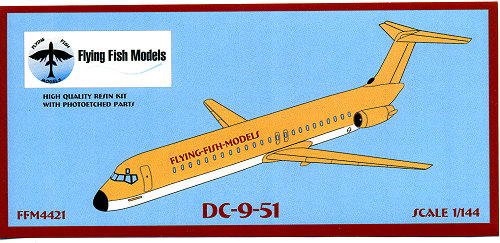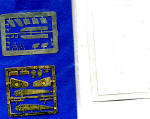
| KIT: | Flying Fish Models 1/144 DC-9-51 |
| KIT #: | FFM 4421 |
| PRICE: | € 55.00 from www.flyingfishmodels.de |
| DECALS: | None supplied |
| REVIEWER: | Scott Van Aken |
| NOTES: | Resin with photo-etch details |

| HISTORY |
The Douglas DC-9 entered service Dec. 8, 1965, and was produced until 1982. More than 976 DC-9s were built -- including 47 C-9 versions for military customers.
The C-9A "Nightingale" was used by the U.S. Air Force to transport sick and injured military personnel. The U.S. Navy and Marine Corps flew C-9B Skytrain IIs. Three VIP transport versions, the VC-9C, were delivered to the Air Force by the end of 1976.
The 90-passenger DC-9-10 was expanded into the 15-foot longer DC-9-30, which first flew on Aug. 1, 1966, and could carry up to 115 passengers. The DC-9-20, which first flew Sept. 18, 1968, was especially useful for short landing fields.
The DC-9-40, first flown Nov. 28, 1967, was 6 feet longer than the -30 and could hold 125 passengers, and the DC-9-50, which first flew in 1974, was 12 feet longer and had the "new-look" interior patterned after the wide-cabin DC-10. The DC-9-80, later redesignated MD-80, launched the family of commercial jet airliners with McDonnell Douglas "MD" designation.
| THE KIT |
 The
Flying Fish kit comes superbly wrapped with all of the bits being enclosed in
foam sheeting to prevent damage. The kit molding itself is first rate. There
were absolutely no molding glitches of any kind on the parts. No air bubbles, no
voids, no chunks in the resin. The parts are nicely engraved and there are no
cabin windows. This is as much because many airliner modelers like to use decals
for those windows.
The
Flying Fish kit comes superbly wrapped with all of the bits being enclosed in
foam sheeting to prevent damage. The kit molding itself is first rate. There
were absolutely no molding glitches of any kind on the parts. No air bubbles, no
voids, no chunks in the resin. The parts are nicely engraved and there are no
cabin windows. This is as much because many airliner modelers like to use decals
for those windows.
The fuselage is in three sections. A tail, central fuselage with the wing roots, and a clear nose section. A cockpit window mask is provided for those who wish to have clear cockpit windows. One would, however, have to paint the nose section black to prevent the primer or exterior color from showing through. The fuselage sections are butt joins after one saws away the molding blocks, but alignment should be easy as the DC-9 has a 'pinched in' section running down the fuselage. The fuselage is divided this way as Flying Fish does a variety of DC-9 variants so this allows a common nose and tail to be used for all the kits.
The wings and tail slot into the fuselage as do the
engines. Engines are two piece constructs that include the pylon. I found that
the intakes and exhaust were superbly molded without any of the usual resin junk
that one often finds located here in other resin kits. Landing gear are provided
as full resin molds as are the flap hinge housings. Again, no detritus was found
in any of the mounting holes and slots, making building so much more of a
pleasant experience. I'm not sure if this would be tail heavy or not as there is
a considerable wheel base with the -51 version, but any weights would require
the builder to drill out the fuselage to install them.

Etched brass is used for the gear doors, wing fence, antennas, windscreen wipers and a few other bits. Instructions are somewhat minimalist but do show the placement of all the etched bits and other construction guidelines. This is a 'white body' kit, meaning that there are no livery decals included. However, there are and have been a number of livery decals made for the DC-9 family that should fit this one without any problem.
| CONCLUSIONS |
This has to be the finest DC-9 I've seen in this scale. The detailing is superb and it looks to be a very straight-forward construct. The ability to do different variants is a big plus for all we have had in the past in 1/144 has been the Airfix DC-9-30, a model that is a bit long in the tooth. This is a kit that you can buy with confidence that you are getting the best.
| REFERENCES |
www.boeing.com
September 2007 My thanks to
Flying Fish Models
If you would like your product reviewed fairly and quickly, please
contact
me or see other details in the
Note to
Contributors. for the review kit. You can order yours direct from the link.
for the review kit. You can order yours direct from the link.